Report Shows a "Universal Set of Dangerous Dog Breeds."
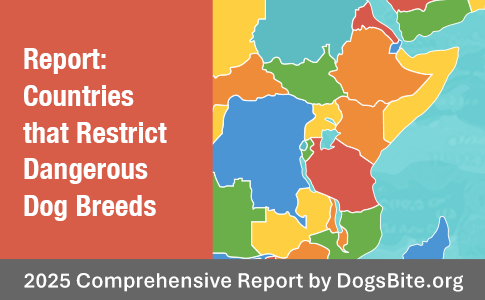
Countries worldwide that restrict dangerous dog breeds by DogsBite.org
View Worldwide Report
DogsBite.org - Starting in 2011, we began maintaining an estimate of breed restriction laws in the United States, including dangerous dog policies governing military housing and policies on Indian reservations. Currently, we maintain model and noted breed restriction laws to provide guidance to jurisdictions who are researching legislative solutions to prevent severe and fatal mauling injuries inflicted by dog breeds with well-identified risks, chiefly pit bulls and their bull breed derivatives.
This year, we are focusing on a global stage by reviewing the number of countries worldwide that restrict dangerous dog breeds, the breeds and restrictions involved, and the density of populations affected by these laws. We estimate that nearly 5 billion people are familiar with or directly affected by these laws across the 6 regions of the world. Many foreign governments recognize that certain dog breeds present an unreasonable risk to the health and safety of citizens and domesticated animals.
Methodology
Over the last 14 months, we gathered news reports of breed restrictions by government bodies worldwide, as well as pet passport and travel applications. We examined importation guidance and requirements issued by government ministries of environment, agriculture, veterinary and health; entry requirements from embassy websites; and country-level laws, statues, and directives. We also examined peer-reviewed studies with references to country-level dangerous dog breed laws.
For our analysis, we divided the world into 6 regions: Africa, Asia, Europe, Latin America & Caribbean, North America, and Oceania. We specified countries with local or national-level breed restrictions, the breeds and controls involved, and if known, the year the national law was enacted. We also specified if a country was a dependency or territory of a sovereign state to identify mutual laws. Greenland, for instance, is an autonomous territory of Denmark that shares Denmark's breed restriction law.
We obtained population data for the world, each region, subregion, country and dependency from WorldOMeter.1 Because population data is continuously updating, we locked down on a data set from November 1, 2024. We calculated the population of 84 countries and dependencies with a local (10) or national-level (74) breed restriction. We also calculated the prevalence (per 1,000 population) of people governed by a national-level dangerous dog breed law within each of the 6 world regions.
To track breed types, we divided the restricted breeds into 7 broad categories: pit bull breeds, mastiff/fighting breeds, rottweiler breed, livestock guardian breeds, northern/spitz breeds, pinscher breeds, and other breeds. We standardized breed name spellings when possible due to language differences. We also retained multiple names for clarity when necessary. For instance, "Boerboel" is always listed as "Boerboel (South African Mastiff)." We identified over 125 different dog breeds.2
(A full list of the 7 restricted dog breed categories is located at the bottom of this analysis.)
All Country Analysis
Jurisdictions in at least 84 countries regulate dangerous dog breeds, of which 99% include pit bull breeds, 89% mastiff/fighting breeds, 45% rottweiler breed, 35% pinscher breeds, 32% northern/spitz breeds, and 26% livestock guardian breeds. The estimated combined population of these countries is 4.99 billion. Notably, at least 21% (18) of countries, mainly in Northern Europe and parts of Asia, have adopted a new national-level breed restriction or strengthened an existing one since the pandemic.3
Of the 84 countries, 21% (18) are dependencies to varying degrees, such as an autonomous country, dependent territory, or special administrative region of a sovereign state. Some share or adhere to the dangerous dog law of the sovereign state. The population of the 18 dependencies makes up 2% of the population of the 84 countries combined. The most populated dependencies are tied to the United Kingdom and China. All 18 dependencies have a national-level law that restricts pit bull breeds.
National-Level Law Analysis
Restricting our analysis to the 74 countries with a national-level breed restriction law allows for richer findings because data for the country population, the affected population, is known. Chart 1 examines the most frequent dog breeds restricted by countries with a national-level law. Chart 2 identifies the number of countries with a national-level law restricting dangerous dog breeds by world region. Chart 3 examines the prevalence (per population 1,000) affected by a national-level law by world region.
Chart 1: Most Frequent Dangerous Dog Breeds
At least 74 countries have a national-level law that regulates dangerous dog breeds, ranging from banning the importation of certain dog breeds to restricting or prohibiting their ownership. Of these national-level laws, 100% target pit bull breeds, 91% mastiff/fighting breeds, 41% rottweiler breed, 32% pinscher breeds, 31% northern/spitz breeds, and 26% livestock guardian breeds. The estimated number of people residing in countries governed by these national laws is approximately 2.7 billion.
Most countries with a national-level law, 91%, restrict both pit bull and mastiff/fighting breeds; 38% restrict the top three breed-types: pit bull, mastiff and rottweiler. Countries that restrict livestock guardian breeds mainly reside in Europe and Asia, specifically Eastern Europe, Western Asia and Southern Asia. These regions surround Central Asia (countries ending in "stan"), which is where a variety of fierce livestock guardian breeds, still used in the blood sport of dogfighting, originate.
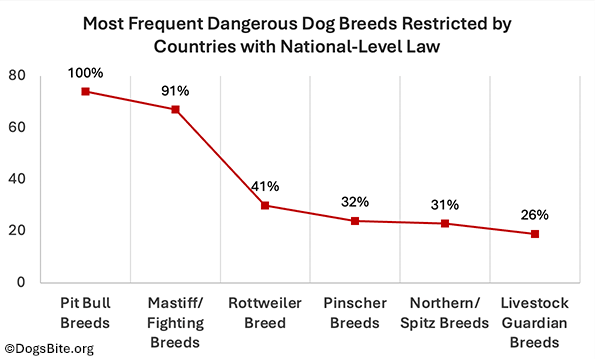
Chart 1: Most frequent dangerous dog breeds restricted by countries with national-level law.
Chart 2: National-Level Laws by World Region
Breaking down national-level breed restriction laws by world region shows that most countries reside in Europe (27), followed by Asia (17), Latin America & Caribbean (13), Oceania (8), Africa (7) and North America (2) -- both countries in the North America region are dependencies.4 Of the 18 dependency countries, most are islands, 67% (12), and most reside in Europe (7), Latin America & Caribbean (3) and Oceania (3). The United Kingdom (UK) is the sovereign state of 56% (10) of these dependencies.
When the adoption year of the national-level breed restriction was known, 23% were enacted during the 1990s after the UK enacted the Dangerous Dogs Act 1991, which prohibited dogs bred for fighting, largely by countries residing in Northern and Eastern Europe.5 From 2000 to 2009, 48% were enacted, reaching countries in Southern and Western Europe, Western Asia and South America. From 2010 to 2025, 28% were enacted, reaching countries in Southern Asia and Northern and Eastern Africa.
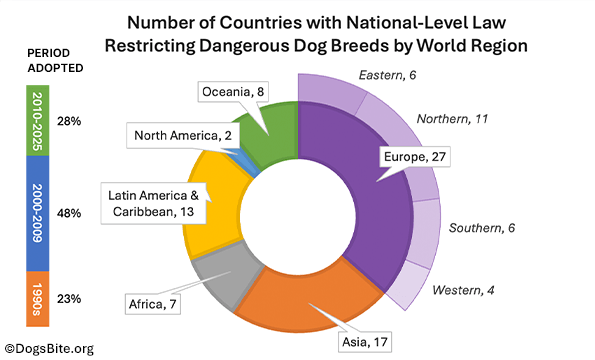
Chart 2: Countries with national-level law restricting dangerous dog breeds by world region.
Chart 3: Prevalence Affected by National-Level Laws
The prevalence of the population affected by a national breed restriction law (per 1,000 population) was calculated for the population of each of the 6 world regions during the period of early November 2024. For instance, of the total 1.5 billion population of the Africa region, the portion of the population governed by this law was 202.9 million. Thus, 134 people per 1,000 population in the region of Africa were governed by a national-level law that restricts dangerous dog breeds during this period.
The Oceania region had the highest prevalence with 947 people per 1,000 population governed by a national-level breed restriction law. Europe followed with 757 people per 1,000 population; Asia with 375 people per 1,000 population; Latin American & Caribbean with 158 per 1,000 population; and Africa with 134. North America was last with 0 people per 1,000 population because the United States and Canada legislate these laws on a local or state-level, such as the Province of Ontario pit bull ban.6
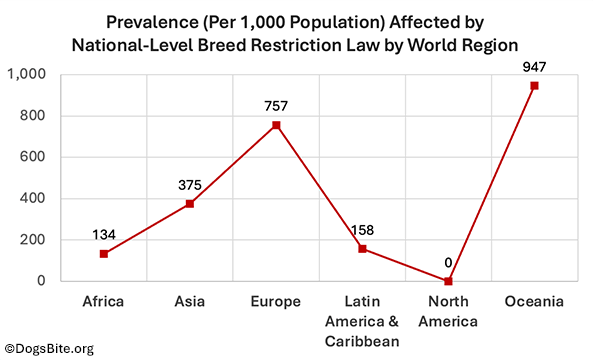
Chart 3: Prevalence of population affected by national-level breed restriction by world region.
Discussion
The majority of people in the world -- nearly 5 billion out of 8.16 billion -- are familiar with or directly affected by a local or national-level breed restriction law throughout the 6 regions of the world. The combined population of people living in 74 countries with a national-level law is 2.7 billion, about one-third of the total world population. Government bodies in at least 84 countries agree the public requires protection from a type of dog breed that has the characteristics of being bred for fighting.
The data is clear that pit bull breeds, due to their selection for dogfighting, are the most restricted breeds worldwide. Of the 74 countries with a national-level breed restriction, 100% include pit bull breeds, primarily, the American pit bull terrier. The next tier of breeds most often restricted are fighting/mastiff breeds, of which 3 were designated in the Dangerous Dogs Act 1991: Fila Brasileiro, Dogo Argentino and Japanese Tosa. 91% of the 74 countries, restrict both fighting breed groups.
At least 24% (18 of 74) of these countries, primarily in Northern Europe and parts of Asia, adopted a new national-level breed restriction or strengthened an existing one since Covid. The UK, which includes England, Wales, Scotland and Northern Ireland, added the XL bully to their prohibition of dogs bred for fighting. Ireland, which already restricted 11 dangerous dog breeds, requiring a muzzle and leash while in public, also adopted the XL bully ban. Ireland had never banned a dog breed before.
Other countries that tightened existing restrictions post-Covid, increased penalties for owners of dangerous dog breeds and prohibited their breeding, such as South Korea, Taiwan and Turkey. Countries enacting a law for the first time, such as Mozambique and Bahrain, acted to reduce the "significant increase" in severe attacks and dogfighting. Since 2018, prior to Covid, the proliferation of dangerous dogs in the US and UK contributed to the rate of fatal dog attacks abruptly rising.
Central Asia Dogfighting
Of the regions we researched for this report, it was the areas of Anatolia and Central and South Asia, as well as the Punjab regions in Pakistan and India, that captured our attention the most. These regions are the origins of multiple fierce livestock guardian breeds. Many Americans are unaware of these lion-sized ancient breeds like the Kangal Shepherd Dog, which is part of Turkey's national heritage, and the Central Asian Shepherd Dog (Ovcharka). Both dog breeds have long been used in dogfighting.7
Dog fight matches in these regions are described as "wrestling" matches to establish dominance,8 unlike the Cajun Rules of "fight to the death."9 The victor is declared when the losing dog exhibits submission, such as yelping. Historically, the fights were used to test which dog had the strength and tenacity to confront and kill a wolf. Dogfighting in Central Asia has grown to be such a popular blood sport that some livestock guardian lines are now only selected for fighting ability and success.10
This region is also the origin of mastiff-bull breed crosses, like the Bully Kutta11 and Gull Dong, used in dogfighting events. Fights among these breeds, and smuggled in pit bulls, in parts of Afghanistan, Pakistan and northwest India are "fights to the death." It's not by chance that in 2024, India attempted to ban the breeding and selling of the primary breeds used in dogfighting. Breed restriction laws in many countries are designed to stop severe attacks on humans and reduce illegal dogfighting.
A recent report from an India animal group, shows that districts in New Delhi, Punjab, Haryana, Rajasthan and Western Uttar Pradesh, India are primarily fighting pit bulls, and in hidden places, like basements and farmhouses, just like is done in the US to dodge authorities. As far back as 2015, India media has documented pit bull fight matches and "tournaments" (highly organized matches) carried out by the urban rich. One animal advocate has amassed over 1400 images of fighting evidence.
Summary
Jurisdictions in all 6 regions of the world, 17 of the 22 subregions and 84 countries have a local or national-level breed restriction law. The estimated combined population of these countries is 4.99 billion. The laws range from banning the importation of dangerous dog breeds to restricting or prohibiting their breeding and ownership. At least 74 of these countries have a national-level breed restriction law, of which 100% include pit bull breeds and 91% include mastiff/fighting breeds.
Of the 84 countries, 21% (18) are dependencies that share the dangerous dog law of the sovereign state. The population of the 18 dependencies makes up 2% of the population of the 84 countries combined. The UK is the sovereign state of 56% (10) of these dependencies. Thus, the influence of the Dangerous Dogs Act 1991 is significant and also provides a legislation blueprint for other countries. All 18 dependencies have a national-level breed restriction law that incorporates pit bull breeds.
Despite the wide variety of different cultures, beliefs, ethnicities and terrains represented in the 84 countries, the governments agree that dog breeds selected for the purpose of fighting pose a danger to the public.
The Oceania region had the highest prevalence of people governed by a national breed restriction law with 947 people per 1,000 population. Oceania is home to the countries of New Zealand and Australia and is the least populated world region. Europe followed with 757 people per 1,000 population and Asia with 375 people per 1,000 population. North America had 0 people per 1,000 population because the two largest countries, Canada and the United States, legislate these laws on a local or state-level.
Finally, by examining the frequency of dog breed names in our report, we can see there is a universal set of dangerous dog breeds, and nearly all have a heritage of fighting. The term, "pit bull" appears 161 times and "Staffordshire" 112 times, together, they capture nearly all pit bull breeds ("bully" appears 33 times, capturing the American bully variations). "Tosa" appears 92 times; "dangerous" 85 times, "fighting" 82 times, "Argentino" 65 times, "Brasileiro" 61 times and "rottweiler" 49 times.
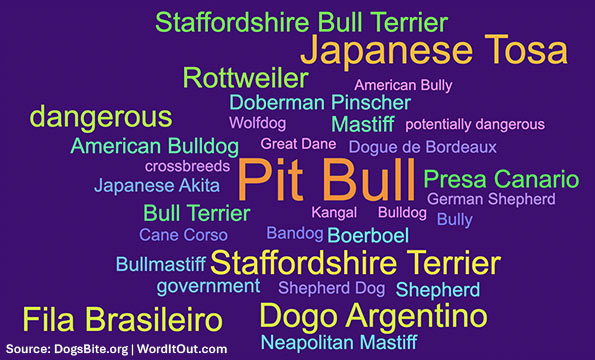
Word cloud of the most frequent dangerous dog breeds restricted by governments worldwide.
Epilogue: Complexities and Subtleties
There are many complexities in this report, some of which, we did not anticipate. For instance, choosing the world region and subregion classification model (such as geographical, geopolitical or culture) and matching it to the correct population data set. Among the geographical schemes there are different regional and subregional classifications, such as the differing divisions of the European subregions. Some classify the British Isles in Western Europe and others in Northern Europe.
There are seismic differences in the levels of self-governance among the dependencies, including: a dependent territory, overseas collectivity, autonomous region, self-governing country in free association with a sovereign state, special administrative region and more. Placing them all under the umbrella of "dependencies to varying degrees," as we did, suited our purpose for identifying countries that inherited or share the breed restriction of the sovereign state, but this is rife with complexity.
Understanding the importation requirements, directives, circulars and statues of each government, a portion of them not in English, was at times challenging. Every country has a unique system of government. With over 240 footnotes, we likely have some invalid or outdated law interpretations. It was also difficult to determine the year the national legislation was enacted. News articles were critical in these areas because they often explain the nuances of the law and when it was enacted.
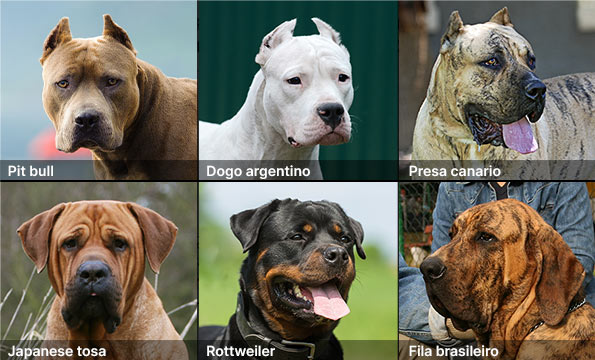
Images of the most frequent dangerous dog breeds restricted by governments worldwide.
Dog Breed Categories:
We did not try to establish a new breed classification system for this report. We merely reviewed all dog breeds in the report and placed them into 7 logical categories for dangerous dog breed restrictions. Most of the classifications were uncomplicated but determining the names of the Central Asian shepherd dogs, which have multiple regional names per breed, was challenging. The Ca de Bou (Majorca Mastiff, Perro de Presa Mallorquin, Malorsky Bulldog, Malorska Doga) also has many names.
When questions did arise about classification within the 7 categories, we first reviewed the breed's classification and history by the Fédération Cynologique Internationale. If further inquiry was needed, we reviewed the AKC, UKC, and Wikipedia breed groups and histories and performed online searches, especially if fighting was in the dog breed's heritage. The most common breeds listed in the "other" category were dominated by police dog breeds -- German and Belgian shepherds, 14% of laws.
2In our count of over 125 different dog breeds, some are regional or colloquial names of the same or similar breed. We thought it was important to keep the country identifying names intact whenever possible, such as "Rednose Pit Bull" in the Netherlands and "Swiss Champagner Bully" in Switzerland, and/or by placing them in parenthesis after the breed name. We only altered breed names if it was a clear spelling or translation issue, such as Kuvasz spelled, "Kuvaz."
3Bahrain, Egypt, England, Iceland, India, Ireland, Isle of Man, Malta, Mozambique, Northern Ireland, Scotland, South Korea, Taiwan, Turkey, Turks and Caicos, Ukraine, United Arab Emirates, and Wales.
4Greenland and Bermuda.
5There are multiple ways to classify the European subregions. The WorldOMeter classification places the British Isles into Northern Europe, as does the United Nations. We also count the 4 individual countries that comprise the United Kingdom. Thus, the 11 Northern Europe countries designated on our chart are: Denmark, England, Faroe Islands, Iceland, Ireland, Isle of Man, Lithuania, Northern Ireland, Norway, Scotland and Wales.
6National-level dog importation laws in the United States are heavily regulated by the federal government regarding disease control. For instance, back in 2023, Centers for Disease and Control (CDC) banned the importation of dogs from dozens of rabies prone countries, causing CDC to undergo a federal rulemaking process about this policy.
7Orhan Yilmaz, Fusun Coskun, Mehmet Ertugrul, Dogfighting in Turkey, Can J App Sci, Issue 2; Vol.05; 21-25; April, 2015.
8,10C. Urbigkit & J. Urbigkit, A Review: The Use of Livestock Protection Dogs in Association with Large Carnivores in the Rocky Mountains, Sheep & Goat Research Journal, Vol 25, 2010.
9The Cajun Rules, by Casino and J.C. Shaw. Variations by G.A. Gaboon Trahan.
11Also known as the Indian Mastiff, Pakistan Mastiff, and the "Beast of the East."
Related articles:
02/02/21: Estimated U.S. Cities, Counties and Military Housing with Breed-Specific Laws (2020-2021)
10/20/16: Back Story of the Montreal Pit Bull Ban; How the American Pit Bull Lobby Operates
08/31/15: Who Can Identify a Pit Bull? A Dog Owner of 'Ordinary Intelligence' Say the High Courts

Thank you for the work you are doing, Colleen. Zero national dog bans in North America – I’d like to see that change, since I live here. It doesn’t appear to be on the current administration’s radar.
I used to think it was good that this isn’t a partisan issue but now I suspect that it simply isn’t seen as an issue at all by any of our leaders. In fact I’m beginning to wonder if any kind of control on dogs in America is a problem no politician wants to touch with a 10-foot pole.
In short, it’s the usual suspects.
The scope of data encompassed in this study is absolutely astonishing. You are to be congratulated on bringing clarity, precision and comprehensiveness to a subject that would seem to defy any attempt to do so. The conclusions provide an indispensable overview of the dog breeds the world has determined merit special controls in order to protect human beings (and other dogs). Not of least importance is the simple, universal inference that breed matters. Thank you.
Amazing work, Colleen! There’s tons of fascinating information. I just read about Kangals. Outside of Turkey, who the heck needs this guardian bear-sized breed? Maybe on a farm with marauding wolves. The Turkish breeder talks about celebrities wanting one of these. Oy vey. This breed does not belong in suburbia. There’s mention of an older woman and a young girl in England both killed by a Kangal.
I have wanted a livestock guardian dog for over a decade to protect my own small dogs from the modern threat of pit bull type dogs/large predatory dogs in my suburban area, it’s the main reason why livestock dogs are still in use even in small hobby farms in the USA.
It’s difficult to find a flock guarding kangal in the US though there are similar livestock guardian breeds such as Anatolians and Central Asian Shepherds available with the primitive instincts that still make for a safer choice than most large guardian breeds. A LGD should use other methods of warning before leaving its flock such as barking and posturing instead of immediately engaging as dogs that leave their flock are no longer protecting their flock. Some LGD breeds are more likely to have different roles in the group making the weaker dogs move out on the perimeters and act as scouts while the more dominant dogs remain closer to the flock according to a study (I’ve forgotten the breed, maybe G Pyrenees). Anyway, aboriginal LGD are a very niche type of guard not given to immediately blast off and grab perceived threats the way bulldog breeds or rotts or whatever top maulers do. LGD were shaped over centuries to be intuitive and don’t need prong collars and leashes and bitework and obedience training under the shepherd, those dogs are still out there though difficult to find. Here is a typical interaction of the Central Asian Shepherd LGD showing how the guard instinct should be, warning bark toward strangers but reasonable threat assessment. https://www.youtube.com/watch?v=_oR0zTgcQn4
Correct on the different roles of LGDs, they work best in pairs, 1 patrols and alerts to danger. The other is the enforcer. I went to a seminar at a goat farm and they explained the roles of the dogs. Further research has confirmed the info they shared. They are NOT pets, they are difficult to contain and are only happy while guarding their flock or herd. They are naturally distrustful of strangers as well. I own a small hobby farm and discounted using LGD dogs to protect my livestock as containing them would be difficult with my fencing system. Kind of amazing how people understand genetics with working dogs but do not understand how dogs bred to kill other animals or people are also responding to genetics.
Yes — thanks for the many years of diligent attention to the news of dog attacks the mainstream news didn’t consider important enough to cover.
This is really good information, thank you so much for your most magnificent and detailed work.
I learned many things today.
May you have the best of luck in all future important matters!
Only a 100% ban on the most dangerous dogs such as Pit Bulls will protect the innocent. Seems the dogs get a pass just like many criminals in our judicial system. Especially the fact that in our state they wait for the dog to bite to do anything and then quarantine for 10-14 days. This is absurd. When will common sense return to our nation and the natural affection for human beings displaced by animals return. In 2023 on the day I learned another child was killed by a family pit bull. Our governor signed a bill prohibiting breed specific ban legislation. I am going to once again contact my representative. Has this issue been brought before congress? Only God’s intervention, I believe will save us. Please Pray. Jesus Christ Saves our most vulnerable.